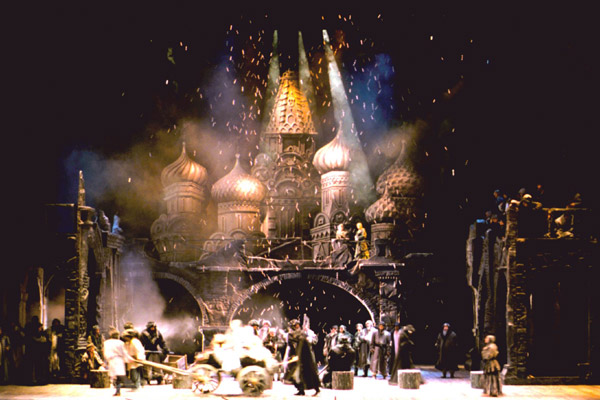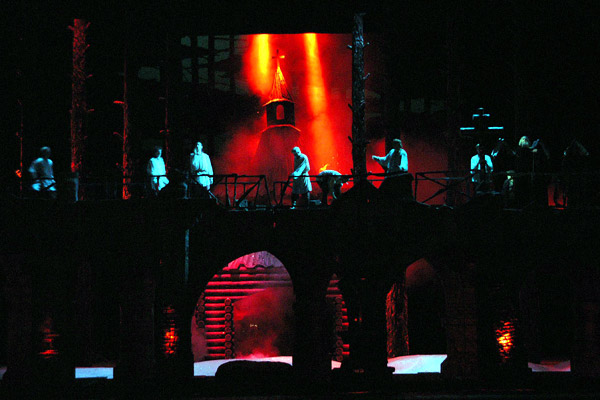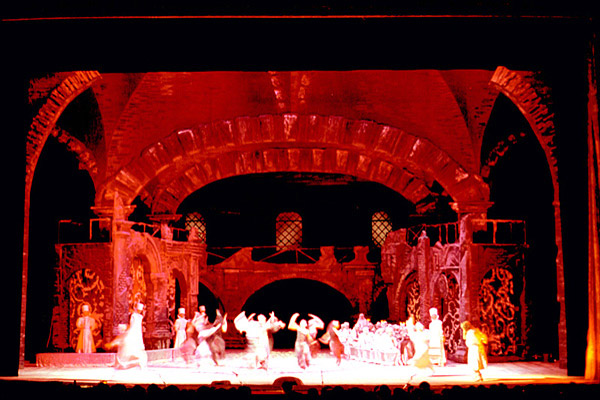Bolshoi means “large” in Russian, which certainly describes the theatre’s fame over the centuries. Founded in 1776 by Peter Urussov, the Bolshoi Theatre took off in 1806 with artists and composers from Italy and France, as well as world-famous local artists.
Since 1840, it has played host to prestigious works by Mozart, Rossini and Auber. Classical ballet was introduced only in the 19th century. Since then, it has welcomed a number of companies, plays, ballets and orchestras (including Milan’s Scala Opera House and the Paris Opera House) on both a national and international level.
Bolshoi employs around 2,500 people, including 900 ballet dancers, musicians, singers and actors. With its magnificent building, elegant rooms, fine costume design, stage set and choreographic details, not to mention its two unusual theatre stages, Bolshoi is undoubtedly one of the most important cultural institutions of contemporary Russia.
Recently, Clay Paky projectors were installed in the Bolshoi Theatre, adding to the existing lighting system which consists of traditional theatre lights. We had a few words with the theatre’s lighting designer, Damir Ismagilov.
In 2002 the Bolshoi Theatre bought Clay Paky Stage Zoom 1200 and CP Color 400. How were they added to the existing lighting system and what role do they play during performances?
The Stage Zooms 1200 are often used with other theatre lights, in performances or scenes requiring up to 1000 lights per scene. However, they are even more characteristic on their own, when creating constrasting lighting effects, for instance.
Now with these new professional moving body projectors, my job as lighting designer offers so much more creative freedom. I can also change the direction of light far more quickly, accurately and precisely during a performance. But the most important thing is that Stage Zoom 1200 is also extremely powerful!
Let’s take for example the scene “Patibolo” from the opera “Khovanshchina” by M. Mussorgsky: at a certain point, a beam has to illuminate a stump on stage with utmost precision from a height of 12 metres. Stage Zoom does this job easily and effectively, which would otherwise be very difficult with ordinary projectors.
Stage Zoom 1200 can do so many jobs on its own: I can use it to follow each performer’s movements on stage, create a stage design using a fixed gobo, add dynamism to a scene using a rotating gobo, or focus the beam on a certain object. In the final scene, the light beams move on different axes, focusing on the centre of the stage or dispersing in all directions.
As we all know, Stage Zooms 1200 are ideal for lighting concerts, live events and other shows. What kind of effects do you need for the theatre lighting?
We don’t look for “spectacular” effects in the Bolshoi Theatre and fixed color lighting is rarely used. However, we have used a lot of graphic effects, including two gobo wheels, one of which has a rotating gobo which can be indexed in any way you like. In our particular case, we used light to depict the texture of rocks or the effects of water, fire or leaves in an innovative way. We used interchangeable Stage Zoom gobos to achieve these effects, after carefully selecting them from the Rosco catalogue with the invaluable help of Doka Media, Clay Paky’s dealer in Russia.
Once we have designed our effect, we also use Stage Zoom 1200 to combine different gobos. We often work with moving metal and glass gobos and add a certain color if necessary. I find this effect particularly evocative.
Damir, could you tell us what you think of CP Color 400?
These are multi-purpose washlights with different filters and lenses that can diffuse or concentrate the beam in a 10° to 80° angle, adapting to all projection needs.
The CMY color mixing system, with pure dichroic filters, gives me any shade I like. It also features a dimming effect and a choice of two 400 Watt discharge lamps, which guarantee superb luminosity. These are all enclosed in a small, light and functional structure.
How do you use CP Color?
Depending on the performance, we can install them on a flight of stairs for lighting a scene, or use them for creating color backdrops. One of the main advantages of CP Color 400 is that it can illuminate large areas from a short distance: this means you can create extraordinary vertical structures with changing colors. It is an ideal tool for the theatre, as it is reliable, versatile and simple to use. It also features fantastic color quality and DMX 512 digital control.
Can you think of a particular scene in which CP Color 400 worked brilliantly?
Again in “Khovanshchina”, we use it for creating backdrops and leave it to work for the entire opera, which can last up to three hours. We paint the decorations in the foreground to get the right shade for this particular setting. The opera’s decorations were specially painted light grey, so that we could “color” them with light. The projectors manage to create any color perfectly: warm or cold tones, or even white. All in perfect harmony with the music. In fact we mustn’t forget that we work in a musical theatre, so music determines the opera’s panorama of light and color.
I have to say that Stage Zoom 1200 and ?P Color 400 have given lighting designers a new standard in lighting quality, which was unheard of until a few years ago. Clay Paky projectors are now being used in all kinds of performances, concerts and plays, which come to life on the new Bolshoi theatre stage.
LATEST NEWS:
During the year 2003, some Clay Paky Stage Profile Plus SV – the most famous moving body beam shapers in the world – have been added to the light design of Bolshoi theatre.









